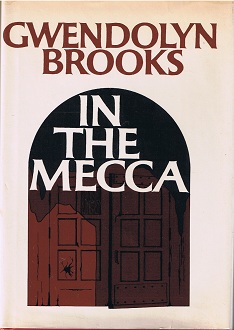 I am reading “In the Mecca” by Gwendolyn Brooks. The poem and the book. The poem, “In the Mecca” is the foundation for the collection of poetry she published back in 1968 or so. The poem is epic which is why you sort of have to live with it for a few days. I have read these works before, all of them, but scattered, never as a collection like I am doing now.
I am reading “In the Mecca” by Gwendolyn Brooks. The poem and the book. The poem, “In the Mecca” is the foundation for the collection of poetry she published back in 1968 or so. The poem is epic which is why you sort of have to live with it for a few days. I have read these works before, all of them, but scattered, never as a collection like I am doing now.
I picked up a pristine copy of “In the Mecca” at a used bookstore a few months ago. I was absolutely knocked silly finding it. The same feeling I had when I found Frank O’Hara’s “Lunch Poems” or when a friend bought a copy of Kamau Braithwaite’s “Other Exiles” for me when he was in Wales.
“In the Mecca” was published by Harper and Row and as the book’s cover jacket notes, this is Brooks’ first collection of poetry in nearly ten years. She already had her Pulitzer for “Annie Allen” and her stature was well established including the publication of her novel, “Maud Martha.”
“in the Mecca” is Brooks as the Black Arts Movement is underway and it has been a book that is not always full accepted by entire reading public. This is the late 1960’s, Dr. King has been assassinated, other leaders in the movement for racial justice are dead as well, and Brooks, part of the city of Chicago, asserts her voice as well rich with black consciousness and community. It is beautiful stuff.
It is clear in reading it that Brooks is energized. I recently read a few articles on the book and listened to a Brooks’ interview and it is obvious the young conscious black people of the time got Brooks to really think about what was going on all around her.
The New York Times’ M.L. Rosenthal reviewed the book in March 1969 and the book receives high praise. There is especially saluting for the poem, “In the Mecca,” a poem Rosenthal says has the “power of its materials and holds the imagination fixed on the horrid predicament of real Americans whose everyday world haunts the nation’s conscience intolerably.”
Prior to Rosenthal’s review, Sarah Webster Fabio in Negro Digest, calls the poem, “In the Mecca, “the best tradition of poetry demonstrating compression, exacting language, imagistic renderings, characterization and dramatization, rhythm and music, compassion, with humor…”
William Stafford briefly reviewed the collection, “In the Mecca” in the journal, Poetry, and called the writing “a special kind of complexity,” and “a steady view, and insight,” though he added that the poems are “confusingly local in reference.” This, without a doubt, is the power of the collection because this is Brooks’ Chicago that she is describing in the poem, the difficult South Side streets she knew well by this time in her writing life.
The title poem, as stated, is quite epic in delivery and is a story. By telling a story in the poem, Brooks showcases her skills at narrative, description, and human feelings. William Hansell, in a 1974 essay on “In the Mecca” described the story as follows:
“…The narrative follows the mother, Mrs. Sallie Smith, from her arrival home after work and her discovery that her daughter Pepita is missing, to the search and eventual capture of the murderer, Jamacian Edward.” This is the poem. But it is Brooks’ delivery of that story which makes a simple tragedy comment on so many other things.
Hansell calls Brooks’ collection “A Rebirth Into Blackness” and that is probably quite accurate considering the title piece and then the poems that follow which are edgy and emotional. “In the Mecca,” the title poem, provides a firm foundation for this theme, but the shorter works maintain this as well. There are poems here for Malcolm X and Medgar Evers. There is a simply incredible poem for the famous Chicago gang, “The Blackstone Rangers” who Brooks conducted a poetry workshop with in Chicago for years. Brooks describes them as “Black, raw, ready…” and “Sores in the city” to aptly present the difficulties of urban life in Chicago. “Their country is a Nation on no map,” Brooks adds.
At the end, as appropriate, there are sermons – “The Sermon on the Warpland” and “The Second Sermon on the Warpland.” If anyone ever wonders about how to wrap up a collection strong and honest, take Brooks’ advice here because these pieces do it perfectly. These two pieces are about black people rising from the degradation of the past, enduring and starting fresh and new in a new age of change. Yet, these are words of humanity as well captured best in the second sermon when Brooks writes: “This is the urgency – Live! and have your blooming in the noise of the whirlwind.”